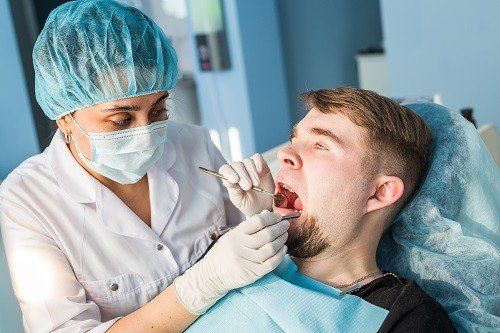How Does Erythroplakia Relate to Oral Cancer?
Erythroplakia
Erythroplakia is a precancerous condition found in the oral cavity, usually in the floor of the mouth or on the tongue, that can lead to the development of oral cancer. This condition often appears as a set of red or white premalignant lesions or ulcers, containing abnormal cells with the potential to become cancer.
Affecting about one to five percent of adults who are 50 years or
older, erythroplakia is often caused by individuals using tobacco products whether
it be smokeless or cigarette form. Chewing tobacco, cigars, pipes, and alcohol,
as well as fractured teeth, all increase the cancer risk. In addition to
tobacco use, erythroplakia can derive from obstinate viral infections or even
just aging. As a form of prevention, especially for tobacco users, it’s
recommended that individuals visit their dentist at least twice a year.
During a visit, dentists and dental hygienists can check the tonsils,
upper throat, and other areas. This allows them to check for swelling, growths,
or lesions. During an exam, a dentist may ask you about your oral health
habits, refer an X-ray, or recommend a visit to an oral surgeon – this helps
determine a better diagnosis and proper treatment. Dentists may also perform a
biopsy to help their analysis. If cancerous tissue is found, then a specialist can
offer treatment, including removing the lesion as well as any surrounding
tissue.
In some cases, however, lesions or abnormal cells may reappear, so it’s
suggested to patients that they monitor the previously affected area closely
for recurrence. As an additional method of prevention, patients are encouraged
to stop smoking and drinking to lessen their risk. While doing this, they
should also focus more on improving dietary and dental habits to maintain and
protect their oral health.
Oral
Cancer
In the event that a patient’s erythroplakia has become malignant and developed
into oral cancer, which occurs in the tongue, mouth, lips, tonsils, or salivary
glands, there are early warning signs to help with early detection, which is
vital for successful treatment. Oral cancer appears more often in men over the
age of 50 than women. As with erythroplakia, smoking and heavy alcohol use
increases one’s risk.
To detect those early warning signs, check in with your dentist
regularly. Notify your dentist if you experience a sore throat that bleeds easily
and doesn’t heal, a thickening of or lump in the cheek, numbness or loss of
feeling in the mouth, red or white patches or lesions inside of the mouth or on
the gums, difficulty chewing and swallowing, or a change in voice.
While one condition is clearly more serious than the other,
erythroplakia can be the preliminary stage for the development of oral cancer
if not taken care of immediately. To encourage good health, patients should
visit their dentist regularly and continue brushing and flossing daily. Taking
proper care of your teeth and accepting treatment not only benefits your oral health
but also your overall health.
Did you know that you can save up to 20 percent off your dental bills with our discount dental plans ? We offer individual, family, and employee plans for small business owners. To learn more, click here.
Copyright: andreypopov
/ 123RF Stock Photo











